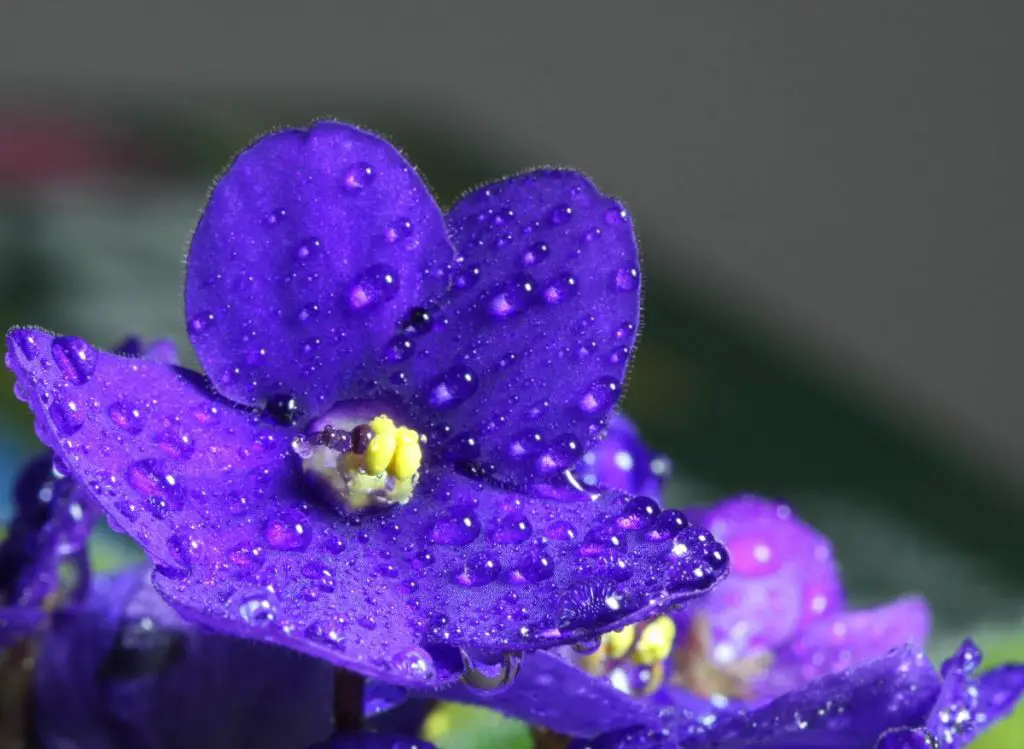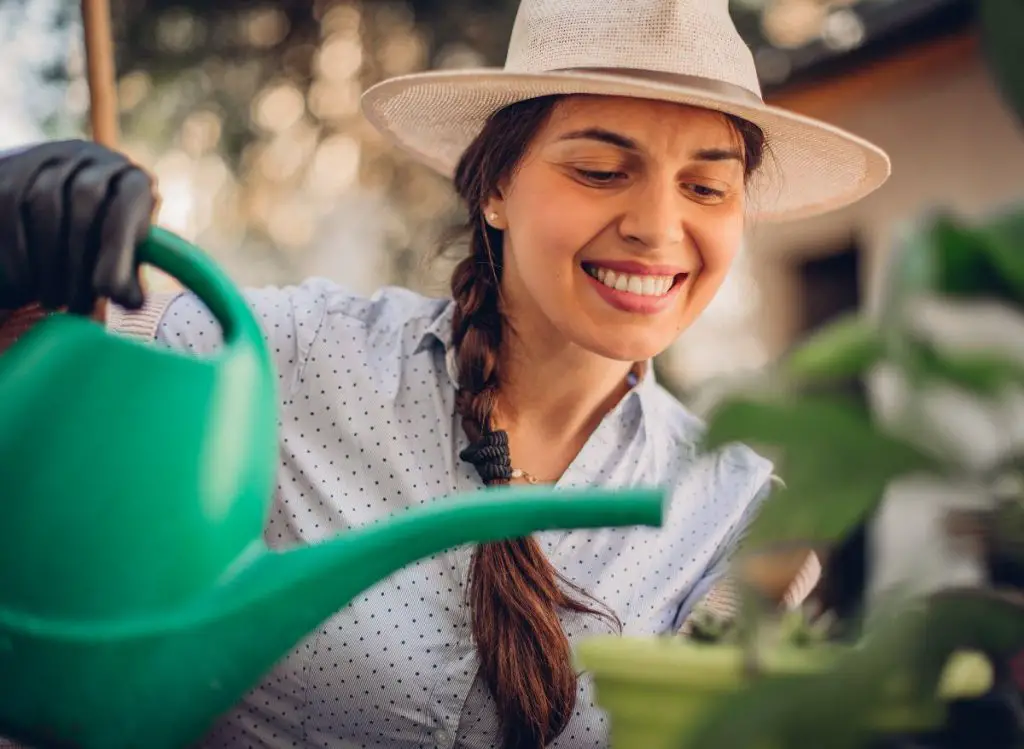Planting and watering plants are exciting and easy when you have the necessary tools. Most plants do not mind how you water them; you can pour water from the top, washing the leaves and allowing the roots to take a sip.
However, things are different with African violets. This delightful plant has watering rules you should follow if you want to see them bloom.
Every African violet’s grower wants to see their plant bloom throughout the year, and watering plays an important role in achieving this goal. So, how to water African violets?
African violet needs regular watering to keep healthy and hydrated. However, the leaves do not like water sitting on them, which may damage leaf cells and cause yellow spots. Therefore, it is advisable to use a special watering container with an extension that can go below the foliage. The goal is to avoid splashing water on the leaves while watering the plant.
In the article, we will discuss how to water your African violets, the frequency of doing so during winter, and what type of water to use.
You might also be wondering how much sun your African violets need, find out all light requirements, including the best artificial lights for African violets.

Do African Violets Actually Need To Be Watered From The Bottom?
Watering an African violet plant from the bottom up is one of the best ways to keep it healthy and growing. Proper watering is essential to successfully growing African violets, according to the University of Georgia.
Like humans, plants can also die from too much or too little water. How often to water and how much varies depending on the plant sizes, soil, pot, and environmental conditions. Let’s discuss how to water African violets from the top.
Here’s How Do You Water African Violets From The Top?
- You can use a turkey baster or a watering can with a long skinny spout.
- Fill the baster or can with room-temperature water and insert the skinny spout underneath the leaves to water the soil. If you are using a cup, you can gently push the leaves to the side and pour the water into the visible soil space.
- Avoid splashing water on the leaves, stems, crowns, or flowers.
- Wait for a few minutes until you see the water drop from the bottom of the pot, and discard any extra water to prevent the plant from rotting.
How Do You Water Your African Violets From The Bottom?
Watering from the bottom is safe because the plant’s leaves do not come into contact with the water. You can follow these steps:
- Fill the bowl, tray, or saucer with water at room temperature
- Place the African violet plant pot in the bowl filled with water, ensuring that at least one inch of the pot is submerged in water.
- Let it sit in the water for about 20 minutes to let the soil wet, and the plant absorbs the water.
- You can discard the remaining water in the tray, but if the soil sucked all the water, you can add more water to the tray and let the pot sit for another 10 minutes.
- Remove the plant pot and return it to its original place
If you have a few African violet collections, you can water them from the bottom by placing them on a bowl of pebbles. How can you do this?
- Add water to the bowl until it covers the pebbles.
- Place the pot bearing African violet on the bowl and allow it to absorb the water. Once the water reduces, add more until it no longer reduces.
- This method is ideal for increasing humidity around the plant and ensuring you do not over-water.
How To Water African Violets Using Self-Watering Pots
Self-watering methods are also perfect if you have a small collection of these plants. The pots take up lots of space and would suit a few African violet plants.
Self-watering pots often have two containers: the inner container holds the plant, and the outer container holds the water.
The inner container is porous, allowing water to move in from the outer container. Alternatively, the inner container could have a cotton wick or openings at the bottom, thus making water absorption easier.
If you use self-watering containers, you can enhance water drainage from the soil by adding a layer of perlite at the inner container’s bottom before placing the potting mix with the African violet plant above it.
What Type Of Water Do I Use To Water African Violets?
African violets need water at room temperature for them to thrive. Too cold water will chill the plant’s roots, resulting in the leaves curling down as the water moves up the plant. If you mistakenly water the plant with cold water from the top, it could result in leaf spotting as it damages the leaf cells.
You should also not water your African violets with hot water because the plant is highly sensitive to high temperatures. If you use the wrong water, you could have a withered plant.
Additionally, you should avoid using chlorine water. Chlorine water could result in leaf burn and reduced chances of flowering. If you use municipal water full of chlorine, place it in the open for at least 24 hours to remove the chlorine before using it to water your African violets.
Salty water is also unsuitable for your African violets because salt build-up on the soil and the rim of the pot will injure the leaves and affect flowering. So, ensure you are using the appropriate water source.
Excess water can also cause fungi to build up, and the plant’s stem and roots could rot, leading to early death. Ensure the water is adequate- not too much or too little.

How Often Do You Water Your African Violets?
Overwatering your African violets can damage the plant, resulting in excessive moisture, creating an ideal environment for root rot, crown rot, and pythium. African violets need slightly moist soil but not soggy to thrive.
So, how often do you water the plant? Water Africa violets once or twice per week, using sufficient water to dampen the soil to a depth of about 6 inches (about 15 cm) each time. Don’t worry if the surface of the soil becomes dry between waterings; generally, the soil underneath remains moist.
In addition, it depends on the watering method and the season you are watering. For instance, you may need to water your African violets more frequently during the hot summer than in the winter.
Bottom watering may also require supplementing with top watering to help flush out extra salt from fertilizers that may build up. This action will help keep the soil fresh, thus enhancing nutrient absorption.
If you use the self-watering method, you can add water to the outer container every 5-7 days. The outer container often comes with a water level indicator to guide you on when you should add more water.
Generally, you know it is time to water your African violet by feeling the topsoil. You know you should water it if it feels dry to the touch. Allow the pot to dry out but not extremely dry between watering sessions to avoid over-watering.
How Often Do You Water African Violets In Winter?
In winter, water African violets every 7 to 10 days. And if you live in a cold climate, like northern Canada, you may need to water your plants every two weeks. As a rule of thumb, African violets require less watering during winter because cooler temperatures and higher humidity levels will typically cause the soil to remain moistened longer.
Growing African violets during winter can be challenging since they need adequate light and appropriate watering. You have the challenge of finding a good window location for proper lighting and determining the watering frequency.
Winter time is characterized by cold weather and limited evaporation, meaning that pots tend to retain water longer.
If you water your African violets using a bowl with pebbles that slowly seep through the pot-bearing plant, the soil will likely remain mist for long. Depending on how dry the soil feels, you may need to add water after two or three weeks.
How Often To Water African Violets Indoors
When growing African violets indoors, only water it once a week by allowing the plant to dry completely between waterings. One clever way to ensure your African violets are never overwatered is by setting up a wicking system.
Best Ways To Water African Violets Indoors
- Let the soil become slightly dry between waterings, but don’t let it become scorched, as wilting can cause African violets’ root damage.
- Keep watering until it drains out the bottom of the pot, and pour off the excess water after 20 to 30 minutes.
- Splashing cold water below 55°F on the leaves can cause ring spots, creating a light green and discolored areas on the plant.
- To keep your African violet healthy, use water at room temperature because a temperature difference between the leaves of even 10°F can cause damage to your plant.
African Violet Light Requirements
Like most plants, African violets need light to grow and bloom. However, they do not like direct hot sun rays, which can burn or stunt their growth. They grow well between 65 and 70 degrees Fahrenheit heat during the day, while at night, you can move the plants to a place with at least 55 degrees Fahrenheit.
During summer, fall or spring, you can place your African violet pot near the north and east-facing window for optimal light absorption. However, ensure the plants are not exposed to direct midday light or cover the plant stand with a sheer curtain to block these rays.
You can shift the position of the plants during winter to face the south or west window during the day while removing the plant to a warmer area in the room at night.
If the light and heat are not adequate during winter, you can supplement using artificial lighting systems. The aim is to provide the plant with the ideal blooming conditions. When installing artificial lighting systems, you should consider the height of the plants and the strength of the fluorescent or LED bulb.
Remember that African violet needs at least 8 hours of darkness and 16 hours of light. If the bulbs have stronger light and heat, they should be installed far above the plant to prevent burning.
Final words
African violets need adequate water to bloom, but overwatering or too little water will be counter-productive. These plants need clean chlorine and salt-free water.
You should use room temperature water instead of cold or hot water. The method of watering is also vital for African violets’ health. Using appropriate equipment, you can water from the top to avoid splashing the water on the plants’ leaves.
Alternatively, you can water from the bottom or use self-watering pots to allow the soil and the plant to absorb water without splashing the leaves. You can water whenever you detect that the top soil is dry to the touch, thus keeping your plant hydrated.


